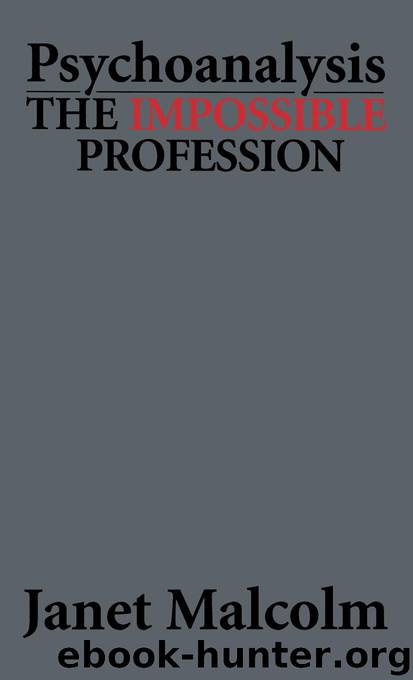Psychoanalysis by Janet Malcolm

Author:Janet Malcolm
Language: eng
Format: epub
Publisher: Jason Aronson, Inc.
Published: 1981-12-14T16:00:00+00:00
6
WHEN I TOLD AARON OF MY IMPRESSIONS OF PSYCHO-analysts as a species of near-saint, he gave me one of the looks that he uses whenever someone or something he considers “unscientific” comes under discussion. But presently, as if in unconscious, grudging acquiescence, he began to speak of two analysts who had sinned against the mores of the analytic community, had traduced its ascetic ideal, and had been savagely punished for their transgression. Their sin was to marry a patient. Or, rather, as Aaron caustically explained (since analysts have been known to marry patients before), their sin was to be prominent, powerful, renowned analysts—leading lights of the analytic world—who married patients. If some nonentity should marry a patient, Aaron said, he would merely be frozen out of the referral network and allowed to sink into even greater obscurity in the institutional world. But if a former president of the American Psychoanalytic Association marries a patient, if a member of the Educational Committee of the New York Psychoanalytic Institute marries a patient, if a training analyst marries a patient, if a brilliant theoretician marries a patient—all of which is what happened here—then he must be ruthlessly dealt with, hurled from his high place, stripped of his honors, and have his head stuck on a pike as an example to others who might be tempted to forswear their analytic vows.
These events occurred years ago, and Aaron had heard about them only at tenth hand. He wasn’t sure that the stories he had heard were accurate in their details—in the version he told me, Analyst X had begun to go out with his patient shortly after her analysis had ended, while Analyst Y had got into a messy triangle during the analysis—but there was no question about what happened when the relationships became known to the leaders of the Institute. The transgressors were instantly disciplined: they were removed from the roster of training analysts, they were divested of their various functions in the ruling structure, they were dismissed from their teaching posts. Their careers in the higher reaches of establishment psychoanalysis were over. They eventually left the city; one of them died a few years ago. The scandal rocked the analytic community, and has become a part of its mythology. Like children watching in fascinated horror as a sibling is caned for something the watchers themselves have done many times in their imagination, analysts talk in hushed tones about the downfall of X and Y, some agreeing with the harsh implacability of the Institute’s position, others feeling that justice should have been tempered with mercy.
I said, “The first analyst was punished for something he did after the analysis. Isn’t that taking things very far?”
Aaron sighed and said, “From patients’ second and third analyses we now know things about the ‘aftereffects’ of analysis which make the line between what is ‘in’ and what is ‘outside’ our work a good deal more tenuous than was previously supposed. In the early days of analysis, people were very casual about things that we’re very careful and nervous about today.
Download
This site does not store any files on its server. We only index and link to content provided by other sites. Please contact the content providers to delete copyright contents if any and email us, we'll remove relevant links or contents immediately.
Rewire Your Anxious Brain by Catherine M. Pittman(18591)
Talking to Strangers by Malcolm Gladwell(13292)
The Art of Thinking Clearly by Rolf Dobelli(10326)
Mindhunter: Inside the FBI's Elite Serial Crime Unit by John E. Douglas & Mark Olshaker(9265)
Becoming Supernatural by Dr. Joe Dispenza(8169)
Change Your Questions, Change Your Life by Marilee Adams(7686)
Nudge - Improving Decisions about Health, Wealth, and Happiness by Thaler Sunstein(7659)
The Road Less Traveled by M. Scott Peck(7556)
The Lost Art of Listening by Michael P. Nichols(7454)
Mastermind: How to Think Like Sherlock Holmes by Maria Konnikova(7279)
Enlightenment Now: The Case for Reason, Science, Humanism, and Progress by Steven Pinker(7274)
Win Bigly by Scott Adams(7141)
The Way of Zen by Alan W. Watts(6555)
Daring Greatly by Brene Brown(6474)
Big Magic: Creative Living Beyond Fear by Elizabeth Gilbert(5679)
Grit by Angela Duckworth(5557)
Ego Is the Enemy by Ryan Holiday(5348)
Men In Love by Nancy Friday(5194)
The Laws of Human Nature by Robert Greene(5082)
